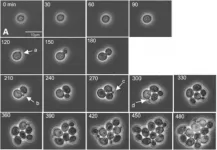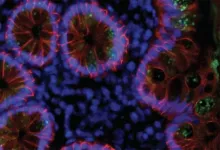The physics behind tumor growth
New theory uses physics to predict the growth stages of cancerous tumors
2021-01-21
(Press-News.org) DURHAM, N.C. -- Researchers at Duke University have developed a predictive theory for tumor growth that approaches the subject from a new point of view. Rather than focusing on the biological mechanisms of cellular growth, the researchers instead use thermodynamics and the physical space the tumor is expanding into to predict its evolution from a single cell to a complex cancerous mass.
The results appeared Jan. 15 in the journal Biosystems.
"When scientists think about cancer, the first thing that comes to mind is biology, and they tend to overlook the physical reality of its growth pattern," said Ehsan Samei, professor of radiology at the Duke University School of Medicine. "There are also issues of how a tumor interacts with its surroundings and provides nutrients to its cells, which is an aspect of the story that so far hasn't been focused on very much."
"Our theory uses fundamental concepts of how natural systems grow and reorganize themselves to gain greater access to flowing systems," said Adrian Bejan, the J.A. Jones Distinguished Professor of Mechanical Engineering at Duke. "It not only explains how this growth should happen, but also why it must happen."
The new work is based on the constructal law, which Bejan penned in 1996, that states that for a system to survive, it must evolve to increase its access to flow. For example, the human vascular system has evolved to provide blood flow through a network of a few large arteries and many small capillaries. River systems, tree branches and modern highway and road networks all reflect the same forces at work.
In the paper, Bejan, Samei and doctoral student Thomas Sauer demonstrate how a tumor's growth and internal reorganization as it grows are directly tied to its need to create greater access to flowing nutrients as well as conduits for removing refuse. They use these insights to predict the growth of cell clusters as a function of structure, and also to predict the critical cluster sizes that mark the transitions from one distinct configuration to the next.
To validate their theory, the researchers compared their predictions with the measurements of several independent studies of cancerous and non-cancerous tumor growth patterns. The results show that their work provides a unifying perspective on the growth of cell clusters on the smallest scales as well as the large-scale dynamics of proliferating cells as described in phenomenological models.
"As the tumor grows, the flow systems get large enough to create visible currents through the vascularization of the tumor," said Bejan. "Our theory reveals the physics behind these sorts of dramatic transitions and predict when they should happen."
For the past 15 years, Samei has been working on computational, extremely detailed models of patients to test new interventions and medical procedures through so-called virtual clinical trials. These trials emulate the patient and the procedures to enable medical evaluations that would otherwise be prohibitively costly or unethical. Until recently, the tumors represented in these virtual patients have been static. But with the new theory of tumor growth, Samei is successfully creating dynamic, growing tumor models that may open new pathways to cancer research.
Samei is currently in the process of generating tumor growth images from his new models, mixing them with images taken from real patients, and testing radiologists to see if they can tell the difference. So far, the results have been promising.
"If the tumors don't grow, the model isn't realistic," said Samei. "We want our platform to be able to accurately model tumor growth so that we can answer the very real question of how often a patient needs to be imaged to determine whether or not their cancer is growing or shrinking."
INFORMATION:
CITATION: "Cell and Extracellular Matrix Growth Theory and its Implications for Tumorigenesis," T.J. Sauer, E. Samei, A. Bejan. Biosystems, Jan. 15, 2021. DOI: 10.1016/j.biosystems.2020.104331
[Attachments] See images for this press release:

ELSE PRESS RELEASES FROM THIS DATE:
2021-01-21
Indigenous peoples' lands may harbour a significant proportion of threatened and endangered species globally, according to University of Queensland-led research.
UQ's Dr Chris O'Bryan and his team conducted the first comprehensive analysis of land mammal composition across mapped Indigenous lands.
"These lands cover more than one-quarter of the Earth, of which a significant proportion is still free from industrial-level human impacts," Dr O'Bryan said.
"As a result, Indigenous peoples and their lands are crucial for the long-term persistence of the planet's biodiversity and ecosystem services.
"Despite this, we know relatively little about what animals, including highly imperilled species, may reside in or depend on these lands."
The team overlayed maps of Indigenous ...
2021-01-21
ITHACA, N.Y. - Far below the gaseous atmospheric shroud on Saturn's largest moon, Titan, lies Kraken Mare, a sea of liquid methane. Cornell University astronomers have estimated that sea to be at least 1,000-feet deep near its center - enough room for a potential robotic submarine to explore.
After sifting through data from one of the final Titan flybys of the Cassini mission, the researchers detailed their findings in "The Bathymetry of Moray Sinus at Titan's Kraken Mare," which published in the Journal of Geophysical Research.
"The depth and composition of each of Titan's seas had already been measured, ...
2021-01-21
University of Illinois Chicago is one of the U.S. sites participating in clinical trials to cure severe red blood congenital diseases such as sickle cell anemia or Thalassemia by safely modifying the DNA of patients' blood cells.
The first cases treated with this approach were recently published in an article co-authored by Dr. Damiano Rondelli, the Michael Reese Professor of Hematology at the UIC College of Medicine. The article reports two patients have been cured of beta thalassemia and sickle cell disease after their own genes were edited with CRISPR-Cas9 technology. The two researchers ...
2021-01-21
New research from McMaster University has found that psychiatric help for mothers with postpartum depression results in healthy changes in the brains of their babies.
The study, published in the journal Depression and Anxiety this week, found treating mothers who had postpartum depression with cognitive behavioural therapy (CBT) not only helped the moms, but resulted in adaptive changes in the brains and behaviour of their infants.
More specifically, after the mothers' treatment, their infants showed healthy changes in their nervous and cardiovascular systems, and they were observed to better regulate their behaviours and emotions by both mothers and fathers.
"In fact, we found that after their moms were treated that their infant's ...
2021-01-21
As the number of people who have fought off SARS-CoV-2 climbs ever higher, a critical question has grown in importance: How long will their immunity to the novel coronavirus last? A new Rockefeller study offers an encouraging answer, suggesting that those who recover from COVID-19 are protected against the virus for at least six months, and likely much longer.
The findings, published in Nature, provide the strongest evidence yet that the immune system "remembers" the virus and, remarkably, continues to improve the quality of antibodies even after the infection has waned. Antibodies produced ...
2021-01-21
BIRMINGHAM, Ala. - University of Alabama at Birmingham polymer and radionuclide chemists report what they say "may represent a major step forward in microcapsule drug delivery systems."
The UAB microcapsules -- labeled with radioactive zirconium-89 -- are the first example of hollow polymer capsules capable of long-term, multiday positron emission tomography, or PET, imaging in vivo. In previous work, UAB researchers showed that the hollow capsules could be filled with a potent dose of the cancer drug doxorubicin, which could then be released by therapeutic ultrasound that ruptures the microcapsules.
PET imaging with zirconium-89 -- which has a half-life of 3.3 days -- allowed the capsules to be traced in test mice up to seven days. The major ...
2021-01-21
NASA-funded research on the 11 largest freshwater lakes in the world coupled field and satellite observations to provide a new understanding of how large bodies of water fix carbon, as well as how a changing climate and lakes interact.
Scientists at the Michigan Tech Research Institute (MTRI) studied the five Laurentian Great Lakes bordering the U.S. and Canada; the three African Great Lakes, Tanganyika, Victoria and Malawi; Lake Baikal in Russia; and Great Bear and Great Slave lakes in Canada.
These 11 lakes hold more than 50% of the surface freshwater that millions of people and countless other creatures rely on, underscoring the importance of understanding how they are being altered by climate change and other factors.
The two Canadian lakes ...
2021-01-21
BUFFALO, N.Y. -- In the dark waters of Lake Superior, a fish species adapted to regain a genetic trait that may have helped its ancient ancestors see in the ocean, a study finds.
The research focuses on kiyis, which inhabit Lake Superior at depths of about 80 to over 200 meters deep. These fish, known to scientists as "Coregonus kiyi," belong to a group of closely related salmonids known as ciscoes.
In contrast to three other Lake Superior ciscoes that dwell and feed in shallower regions of water, the kiyis are far more likely to carry a version of the rhodopsin gene that probably improves vision in dim "blue-shifted" waters, ...
2021-01-21
Curtin University researchers have uncovered a method of making silicon, found commonly in electronics such as phones, cameras and computers, at room temperature.
The new technique works by replacing extreme heat with electrical currents to produce the same chemical reaction that turns silica into silicon at a reduced economic and environmental cost.
Lead researcher, PhD candidate Song Zhang from Curtin's School of Molecular and Life Sciences said that while the team's discovery was made at the nanoscale, it defines a way of replacing thermochemical processes with electrochemical processes, which ...
2021-01-21
With the recent explosive demand for data storage, ranging from data centers to various smart and connected devices, the need for higher-capacity and more compact memory devices is constantly increasing. As a result, semiconductor devices are now moving from 2D to 3D. The 3D-NAND flash memory is the most commercially successful 3D semiconductor device today, and its demand for supporting our data-driven world is now growing exponentially.
The scaling law for 3D devices is achieved by stacking more and more semiconductor layers, well above 100 layers, in a more reliable way. As each layer thickness corresponds to the effective channel length, accurate characterization and control of layer-by-layer thickness is critical. To date, ...
LAST 30 PRESS RELEASES:
[Press-News.org] The physics behind tumor growth
New theory uses physics to predict the growth stages of cancerous tumors





